The science behind our illustrations
We worked together with our scientific contributors to develop illustrations that are scientifically accurate and illustrate in a demonstrative way the discovery explained. We present below three of our scientific illustrations and the reasoning behind them.
Scene of Einstein and the Special Theory of Relativity
“A very common thought experiment linked to special relativity and the constant speed of light is based on a train and how two observers, one on the train and the other off the train, experience time dilation. Because the speed of light is constant, the clock (time) runs slower on the train compared to off the train, as long as you observe off the train. Time dilation leads to what is known as the twin paradox.”
In the specific scene we can see how Albert observes time differently on the train and off the train, by showing an indicative time difference in the two respective clocks.
Scene of Edwin Hubble and the Galaxies “Redshift & Blueshift”
“Have you ever noticed how a car engine sounds a higher pitch when it’s coming towards you and lower when it’s going away? Something similar happens with light when stars or galaxies are moving relative to Earth; light from objects moving towards Earth appears to have a higher frequency while objects moving away from Earth appear to have a lower frequency.
Our eyes interpret different frequencies and wavelengths of light as different colors; compared to our yellow Sun, lower frequency (longer wavelength) light will appear redder while higher frequency (shorter wavelength) light will appear bluer. Objects moving away from Earth are therefore said to be in “Redshift” and objects moving closer to Earth are said to be in “Blueshift” because of the change in light wavelength”
- Scott Bigler
Scene of Newton and the Laws of Motion
The apple falling on Newton’s head demonstrates all three of his laws of motion in one example:
1. (Inertia) The apple falls from the tree because gravity causes it to accelerate downward,
2. (Force) The force of the apple hitting Newton is proportional to the size (mass) of the apple, and
3. (Reaction) Hitting Newton also applies an equal and opposite force to the apple, which stops its fall.”
- Scott Bigler
Introducing complex scientific discoveries early and simple
Have you ever thought of science with fondness and as part of your early childhood memories? This is exactly what we aim to achieve by introducing complex scientific discoveries such as gravity and the special theory of relativity in a rhymed adventure around the world with aquarelle illustrations.
Science, after all, is about curiosity and inspiration to learn about the world’s wonders, understand its workings, and dare to imagine ourselves solving some of its unanswered questions.
If you enjoyed learning about how we illustrated scientific concepts, you mighty want to look at the scientific activities we developed: from doing math in the sand all the way to looking up at the stars in the night sky.




